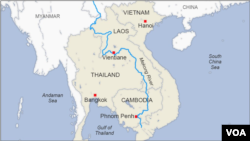China informed downstream Mekong river neighbors of a 20-day water restriction at its southernmost dam on the waterway six days after it started holding back water on Dec. 31, drawing a mix of credit for sharing data with downstream governments and criticism for not giving Thailand, Cambodia and others advance notice.
A statement issued Wednesday by the Mekong River Commission, an intergovernment agency that works with the governments of Laos, Vietnam, Thailand and Cambodia, to manage the 2,703-mile river’s resources, said that China promised that the river’s flow held back at the Jinghong Dam "will be gradually restored to its normal operation status on January 25."
Thailand’s Office of Natural water Resources said it received notification from China on Tuesday that the water discharge would be nearly halved.
“The ministry of water resources of China has notified the Office of Natural Water Resources… that it has reduced water discharge from Jinghong Dam on China’s border from 1,904 cu. m. to 1,000 cu. m. per second from Jan. 5 to 24. After that the discharge will be increased back to normal,” Somkiat Prajamwong, the director of the ONWR said in the statement.
The notifications came shortly after a new U.S.-funded monitoring system revealed that China had not told the downstream countries that it was holding back water starting on Dec. 31.
The Washington-based Stimson Center’s Mekong Dam Monitor, which uses satellite imagery to keep tabs on water levels along the Mekong, said water levels were low at several checkpoints in three downstream countries in its update for the week of Dec. 28, 2020, to Jan. 3, 2021.
“Jinghong's sudden restrictions of water starting 12/31 caused a sudden 1-meter drop in river level 380 kilometers downstream at Chiang Saen on 1/3-4. LMC and MRC data confirm this, but as of 1/4, China provided no notification of the sudden and unusual change that will impact fish and farming processes downstream,” the update said.
“Also, the reservoirs for the Nam Ou 5 dam in Laos and the Don Sahong Dam on the mainstream in Laos are still at all-time lows. And finally, the Tonle Sap gauges show the lake in retreat after an extremely late and short flood season,” it said.
Cambodia’s Tonle Sap, a large inland lake whose waters ebb and flow with the annual cycle of the river connecting it to the Mekong, has been drying at a rapid rate in recent years, threatening the fish stocks providing millions of Cambodians with their main source of protein.
Brian Eyler, the director of the Stimson Center’s Southeast Asia Program and the Monitor’s project lead, told RFA’s Lao Service that China’s decision to hold back water disrupts the Mekong’s ecology.
“The restrictions of water from the downstream are certainly not welcome. They are unusual for this time of year and not part of the Mekong’s natural cycle. However, what is welcome are China's notification of its changes and dam operations that are causing the restrictions,” Eyler said.
“China is making good on its promise to notify downstream countries when it changes its dam operations. But there are some inconsistencies with the notification,” he said.
He said that China did not notify the downstream countries prior to holding back the water. After it became aware of eyewitness accounts of the river level dropping downstream, the monitor was able to identify the Dec. 31 restriction in data.
“So, we began to get the word out. We alerted the Mekong River Commission. We provided alerts on social media and also said that China provided no notification. The Mekong River Commission had also observed the drop at the data portal and confirmed that China had provided no notification,” Eyler said.
“Within 12 hours after our actions, China did provide a notification. So, China's notification was late. It seemed to be compelled by external actors rather than of its own admission and own volition,” he said.
China has been the target of criticism from the international community for its cascade of 11 megadams on the river. The lower Mekong basin experienced severe drought over the past year, with stretches of the river even drying up entirely. The dams in China are at least partly to blame.
In October 2020, Beijing agreed to share data with the MRC, as some 60 million people in Thailand, Laos, Cambodia, and Vietnam use the river for agriculture and fishing.
Reported by RFA’s Lao Service and BenarNews, an RFA-affiliated online news service. Translated by Max Avary. Written in English by Eugene Whong.










